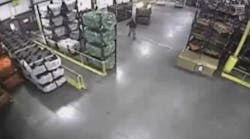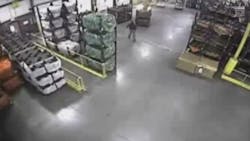We’ve assembled quite a collection of video galleries since we started doing them a few months ago. Many are lighthearted, but a few are dead serious—like the one we just posted on pedestrian safety in the workplace. As you’ll see, video material was fairly easy to find. That’s probably because, as OSHA states, struck-by incidents are among the most common causes of injury in the workplace.
Combine the frequency of such accidents with the prevalence of security cameras in workplaces, and you can compile a video training manual. Professional trainers like Jim Shephard and David Hoover have seen enough accidents waiting to happen on their site visits that these situations replay in their heads. Shephard, president of Shephard's Industrial Training Systems, says that when he entered the material handling industry more than 30 years ago it was the operators who were injured or killed most often on the job, not pedestrians. That has changed.
"Pedestrians top the charts, with minor to major incidents," he says. "More people, more product, more equipment, faster operations and fewer people following simple rules. In most cases pedestrians assume the operator will see them and that they have the right of way, anyway. This may be true, but they can end up being dead right."
When it come to deciding who has the right of way in the workplace, Shephard recommends adopting the philosophy that the other guy does.
That philosophy is not displayed in any of the videos included in our Struck-By gallery. David Hoover, of Forklift Training Systems, tries to turn that negative into a positive by using such videos in classroom settings to get his message about safety basics to sink in. Showing the bloody consequences of dismissing safety may seem ghoulish, but it’s effective. Here are a few of his takeaways from these cases:
- Operators must always look in the direction of their travel. This could be front, back, left, right, up or down. They also need to look BEFORE moving in that direction. “Some people just never look,” he says.”Others do a ‘casual look,’ which is turning their head about halfway and casually looking that way. They are not looking fully in that direction, however, and therefore are missing many things.” Another accident instigator he cites is the "late looker," who does look but only after already moving a few feet or more. This casual glance is often too late to save a pedestrian from injury or death.
- Mirrors are fine but not as good as an operator’s naked eyes. “We can argue all day whether mirrors make operations safer,” Hoover says, “but the fact remains the job can be done safely without mirrors. OSHA does not mandate them.” If mirrors are used they must be in good working order, adjusted properly and clean. They should also be the right type. Center-mounted convex mirrors can show the entire rear area vs. having one mounted on each side of the vehicle.
- Drive in reverse—but correctly! If a load is too tall to get a decent line of sight over it, an operator has no choice but to drive in reverse, or use a spotter to guide them. Hoover notes that spotters are common at construction sites, but he regrets that he doesn’t see them used very much in general industry.
- Operators should take responsibility for pedestrian safety. That means keeping the danger zone around the forklift free of pedestrians whenever possible. “The operator is certified and has more extensive forklift training than a pedestrian would,” Hoover says. “The operator should know the distance from the truck and/or load that poses potential danger, and they should caution pedestrians in the area.” Pay special attention to the container handling fatality depicted in our “struck-by” gallery. It shows how hard it can be for co-workers on foot to judge safe distances around a working vehicle. In cases like this, danger can extend to someone as far as 40 feet from a forklift. It’s an employer’s responsibility to establish policies governing pedestrian walkways and proximity around working machinery.
OSHA expects employers to provide safe workplaces regardless of whether there are written standards and practices in place. One written guideline serves as an inspector’s trump card. It’s called the general duty clause, and it states:
“Each employer shall furnish to its employees employment and a place of employment which are free from recognized hazards that are causing or are likely to cause death or serious physical harm to employees.”
If you’re going to be struck by anything, let it be that.
(Click HERE to go to the Video Gallery.)




